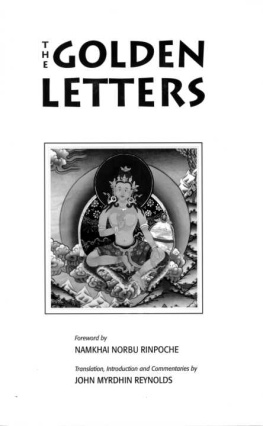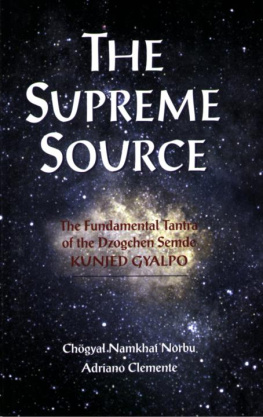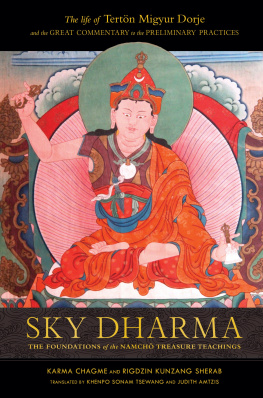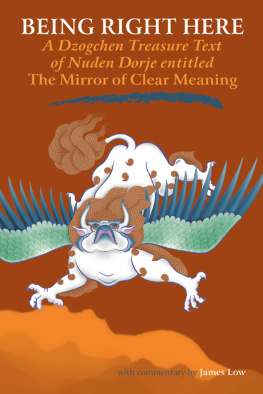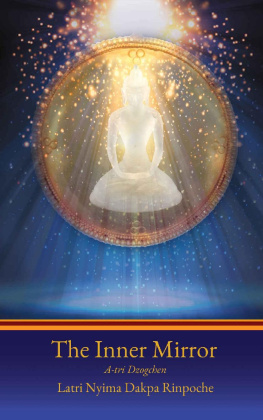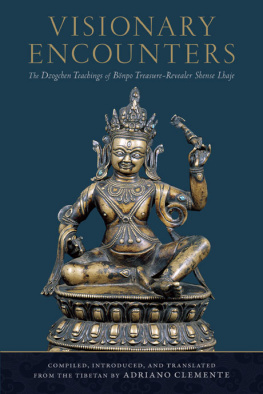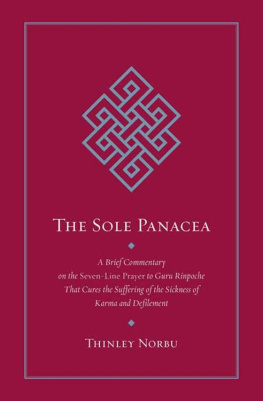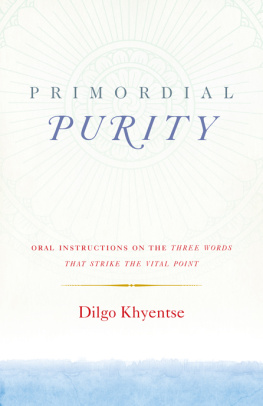Chogyal Namkhai Norbu - The Golden Letters
Here you can read online Chogyal Namkhai Norbu - The Golden Letters full text of the book (entire story) in english for free. Download pdf and epub, get meaning, cover and reviews about this ebook. year: 1996, publisher: Snow Lion, genre: Religion. Description of the work, (preface) as well as reviews are available. Best literature library LitArk.com created for fans of good reading and offers a wide selection of genres:
Romance novel
Science fiction
Adventure
Detective
Science
History
Home and family
Prose
Art
Politics
Computer
Non-fiction
Religion
Business
Children
Humor
Choose a favorite category and find really read worthwhile books. Enjoy immersion in the world of imagination, feel the emotions of the characters or learn something new for yourself, make an fascinating discovery.
- Book:The Golden Letters
- Author:
- Publisher:Snow Lion
- Genre:
- Year:1996
- Rating:4 / 5
- Favourites:Add to favourites
- Your mark:
- 80
- 1
- 2
- 3
- 4
- 5
The Golden Letters: summary, description and annotation
We offer to read an annotation, description, summary or preface (depends on what the author of the book "The Golden Letters" wrote himself). If you haven't found the necessary information about the book — write in the comments, we will try to find it.
The Golden Letters — read online for free the complete book (whole text) full work
Below is the text of the book, divided by pages. System saving the place of the last page read, allows you to conveniently read the book "The Golden Letters" online for free, without having to search again every time where you left off. Put a bookmark, and you can go to the page where you finished reading at any time.
Font size:
Interval:
Bookmark:

the first teacher of Dzogchen,
together with a commentary by
Dza Patrul Rinpoche
entitled "The Special Teaching of the
Wise and Glorious King"
Foreword by
NAMKHAI NORBU RINPOCHE
Translation, Introduction and Commentaries by
JOHN MYRDHIN REYNOLDS
Introduction
PART ONE: The Three Statements That Strike the Essential Points
PART THREE: Historical Origins of Dzogchen
Indian Buddhism
Ch'an Buddhism
Bon
First of all, I wish to thank Namkhai Norbu Rinpoche, who first made clear to me the crucial importance of these three statements of Garab Dorje for the understanding of Dzogchen as a whole (Potter Valley, California, 1980); and for his invaluable help in translating the present texts, especially the 'Das-rjes. I also extend my thanks to Rinpoche for writing a foreword to this book. Moreover, I am grateful for the transmissions I have received on the Patrul Rinpoche text, the translation of which is also found in this book, from several masters of the Nyingmapa tradition, notably H. H. Dudjom Rinpoche, Lama Gonpo Tsedan Rinpoche, and Lama Tharchin Rinpoche.
I translated this Patrul Rinpoche text, known as the mKhas-pa sri rgyal-po'i khyad-chos, "The Special Teaching of the Wise and Glorious King," which is among the best-known commentaries in Tibetan on these three statements, while I was living at Baudha in the Kathmandu valley of Nepal (Spring 1978). My thanks go to Ani Lodro Palmo for having kindly provided me with a copy of this text, bringing it with her from Tashi Jong in Himachal Pradesh. Over many cups of tea in the early morning hours at the Bir Hotel, during the course of several days, I completed the translation. But then I set it aside for several years. In the meantime I came to read several other translations of the same text by Sogyal Rinpoche, by Tulku Thondup, and by Keith Dowman. A few years ago, I took out my translation once again and revised it somewhat, bringing it into line with my revised translations of Tibetan Buddhist technical terms. When I considered the translation for publication, it was suggested that I include with it a translation of the 'Das-rjes, which is said to represent the actual text of Garab Dorje's last testament. This effort was inspired by my program of going back to the original texts of the Dzogchen tradition, and not just relying on the expositions, excellent as they may be, of more recent masters of that tradition, which is generally the case among the Tibetans themselves.
This latter text, unlike the work of Patrul Rinpoche, turned out to be written in a difficult Tibetan language, being exceedingly terse and elliptical, rather like college lecture notes. Moreover, the presentation of Thekchod (khregs-chod) and Thodgal (thod-rgal) were mixed up together in the text, instead of being rigidly separated, as is the case with the later Terma tradition. During the course of three afternoons at a retreat in Jamestown, Colorado (July 1987), Namkhai Norbu Rinpoche generously provided several hours during which we went over the translation of this text. The results of this will also be seen in the interlinear commentary and notes which follow the translation. Because of the linguistic difficulties of the text and the necessity of interspersing the translation of the root text with the notes (mchan) found in the Tibetan, as well as with some additional phrases in parentheses supplied by the translator in order to facilitate the reading and understanding of the text, I decided that the best method would be to provide a running and rather free translation uninterrupted by the notes, and to follow this with a strictly literal translation along with an interlinear commentary where necessary.
For a justification of my method of translation, first developed in a seminar on the translation of Buddhist technical terms with Professor Edward Conze in 1967-68 (University of Washington, Seattle), see the section entitled "Note on the Translation of Dzogchen Technical Terms." A glossary of Dzogchen terms in Tibetan and English is provided at the back of the book, but the explanations of why I translate certain Tibetan terms in the way I do will be found in the notes and commentaries. I leave these out of the texts of the translations themselves in order not to burden the reader. This book is primarily a presentation of the teachings of Dzogchen found in these two texts, rather than a philological or historical study of the origins of the Dzogchen tradition. There exist a number of biographical or hagiographical accounts of the life of Garab Dorje preserved in the Nyingmapa tradition and they do not agree in all details. So, by way of biography I have included here only one translation: the account of Garab Dorje found in the Lo-rgyus chen-mo of Zhangton Tashi Dorje (1097-1167) contained in the Bi-ma snying-thig collection of Longchen Rabjampa (vol. 7, pt. III). This is probably one of the oldest extant accounts of the historical career of Garab Dorje. I also make reference to the account found in the 'Dra 'bag chen-mo (author unknown), the famous biography of Vairochana the translator, which has been in existence since at least the thirteenth century, but which contains material which is much older. I also include here, of interest to practitioners, a short Guru Sadhana (bla-sgrub) for Garab Dorje written by Khyentse Chokyi Lodro Rinpoche (1896-1959). The transmission for this sadhana was graciously given by Sogyal Rinpoche during his visit to the spring retreat at Merigar, Italy, in April 1985.
Since many of the extant early texts for the Dzogchen tradition come from the tenth and eleventh centuries of our era, some modern scholars propose that Dzogchen was actually invented at that time by certain unscrupulous Nyingmapa and Bonpo Lamas. According to this argument, these Lamas, wishing to have their unorthodox doctrines accepted by Tibetans generally, attributed these texts to certain early heroic historical figures, especially to Padmasambhava and Vimalamitra in the eighth century. However, this theory falls into an error common among academic scholars whose knowledge is limited to the study of written texts, where it is assumed that an idea or a practice did not exist until it was written down in some text. This approach, of course, overlooks and disregards the importance of oral tradition (snyan brgyud) with regard to spiritual teachings. The reality of oral tradition I have experienced for myself first-hand during years of residence among Tibetan Lamas in India and Nepal. Accordingly, I have no doubt that the Dzogchen teachings go back to the eighth century in Tibet with Padmasambhava, Vimalamitra, and Vairochana, just as is claimed in the tradition, and most likely before that to India and to Uddiyana. Dzogchen was not something created ex nihilo in the tenth century. Certain manuscripts from the Tun Huang library of the tenth century prove its existence at that time. Even if it could be definitively shown, however, that Dzogchen as an independent movement first came into existence in the tenth century with Nubchen Sangye Yeshe (gNubs-chen sangs-rgyas ye-shes), Shenchen Luga (gShen-chen klu-dga'), and others, this two-hundred-year gap between the eighth and the tenth centuries would make no difference with respect to the universal truth of the Dzogchen teachings as a path to liberation and enlightenment. Spiritual truth transcends history. I allude to some of these philological and historical problems in the section entitled "Historical Origins of Dzogchen," but a fuller consideration of the problems involved must be left for a later discussion.
Font size:
Interval:
Bookmark:
Similar books «The Golden Letters»
Look at similar books to The Golden Letters. We have selected literature similar in name and meaning in the hope of providing readers with more options to find new, interesting, not yet read works.
Discussion, reviews of the book The Golden Letters and just readers' own opinions. Leave your comments, write what you think about the work, its meaning or the main characters. Specify what exactly you liked and what you didn't like, and why you think so.

